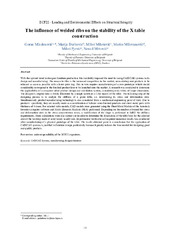Приказ основних података о документу
The influence of welded ribs on the stability of the X table construction
| dc.creator | Mladenović, Goran | |
| dc.creator | Đurković, Marija | |
| dc.creator | Milošević, Miloš | |
| dc.creator | Milovanović, Marko | |
| dc.creator | Pjević, Miloš | |
| dc.creator | Mitrović, Nenad | |
| dc.date.accessioned | 2023-03-07T11:08:42Z | |
| dc.date.available | 2023-03-07T11:08:42Z | |
| dc.date.issued | 2018 | |
| dc.identifier.isbn | 978-86-900686-0-9 | |
| dc.identifier.uri | https://machinery.mas.bg.ac.rs/handle/123456789/5415 | |
| dc.description.abstract | With the upward trend in designer furniture production, this inevitably imposed the need for using CAD/CAE systems in its design and manufacturing. The reason for this is the increased competition in the market, necessitating new products to be released as soon as possible with a lower price tag. This in turn requires manufacturing of a zero prototype which should considerably correspond to the finished product later to be launched onto the market. A research was conducted to determine the applicability of a computer aided product design and calculation system, considering only tables of larger dimensions. The designer's original idea is firstly illustrated by a rough sketch or a CAD model of the table. The following step of the designing process is to analyze the stiffness of a given table, i.e. determining its stress and deformation state. Simultaneously, product manufacturing technology is also considered from a mechanical engineering point of view. Due to products’ specificity, they are usually made as a combination of tubular semi-finished products and sheet metal parts with thickness of 4-6mm. For selected table models, CAD models were generated using the Sheet Metal Module of the Autodesk Inventor computer software and Finite Elements Analysis (FEA) performed. Depending on the numbers obtained for stress and deformation state in the stress concentration zones, a modification of the shape is performed to fulfill the stiffness requirements. Static calculations were also carried out in order to determine the dimensions of the table base for the selected area of the worktop made of solid wood; usually oak. Experimental verification of acquired numerical results was conducted after manufacturing of a physical prototype of the table. The results obtained point to a conclusion that the application of CAD/CAE systems is justified in furniture design, particularly because it greatly reduces the time needed for designing good and quality products. | sr |
| dc.language.iso | en | sr |
| dc.publisher | University of Belgrade, faculty of Mechanical Engineering | sr |
| dc.relation | info:eu-repo/grantAgreement/MESTD/Technological Development (TD or TR)/35022/RS// | sr |
| dc.rights | openAccess | sr |
| dc.source | 22nd European Conference of Fracture "ECF22" - Book of Abstracts | sr |
| dc.subject | CAD/CAE Systems | sr |
| dc.subject | manufacturing | sr |
| dc.subject | designer furniture | sr |
| dc.title | The influence of welded ribs on the stability of the X table construction | sr |
| dc.type | conferenceObject | sr |
| dc.rights.license | ARR | sr |
| dc.citation.epage | 132 | |
| dc.citation.rank | M34 | |
| dc.citation.spage | 132 | |
| dc.identifier.fulltext | http://machinery.mas.bg.ac.rs/bitstream/id/13356/mp_ecf22_b.pdf | |
| dc.identifier.rcub | https://hdl.handle.net/21.15107/rcub_machinery_5415 | |
| dc.type.version | publishedVersion | sr |


